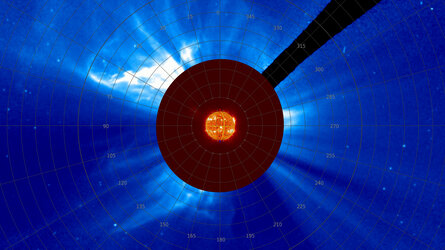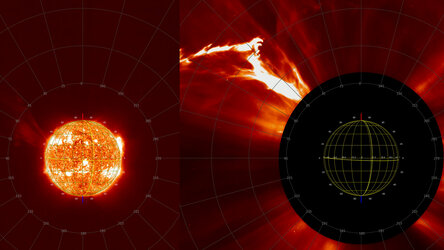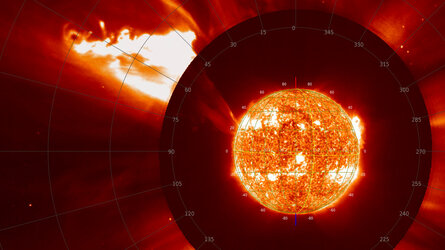Accept all cookies Accept only essential cookies See our Cookie Notice

About ESA
The European Space Agency (ESA) is Europe’s gateway to space. Its mission is to shape the development of Europe’s space capability and ensure that investment in space continues to deliver benefits to the citizens of Europe and the world.
Highlights
ESA - United space in Europe
This is ESA ESA facts Member States & Cooperating States Funding Director General Top management For Member State Delegations European vision European Space Policy ESA & EU Space Councils Responsibility & Sustainability Annual Report Calendar of meetings Corporate newsEstablishments & sites
ESA Headquarters ESA ESTEC ESA ESOC ESA ESRIN ESA EAC ESA ESAC Europe's Spaceport ESA ESEC ESA ECSAT Brussels Office Washington OfficeWorking with ESA
Business with ESA ESA Commercialisation Gateway Law at ESA Careers Cyber resilience at ESA IT at ESA Newsroom Partnerships Merchandising Licence Education Open Space Innovation Platform Integrity and Reporting Administrative Tribunal Health and SafetyMore about ESA
History ESA Historical Archives Exhibitions Publications Art & Culture ESA Merchandise Kids Diversity ESA Brand CentreSpace in Member States
Find out more about space activities in our 23 Member States, and understand how ESA works together with their national agencies, institutions and organisations.
Science & Exploration
Exploring our Solar System and unlocking the secrets of the Universe
Go to topicAstronauts
Missions
Juice Euclid Webb Solar Orbiter BepiColombo Gaia ExoMars Cheops Exoplanet missions More missionsActivities
International Space Station Orion service module Gateway Concordia Caves & Pangaea BenefitsLatest
Space Safety
Protecting life and infrastructure on Earth and in orbit
Go to topicAsteroids
Asteroids and Planetary Defence Asteroid danger explained Flyeye telescope: asteroid detection Hera mission: asteroid deflection Near-Earth Object Coordination CentreSpace junk
About space debris Space debris by the numbers Space Environment Report In space refuelling, refurbishing and removingSafety from space
Clean Space ecodesign Zero Debris Technologies Space for Earth Supporting Sustainable DevelopmentLatest
Applications
Using space to benefit citizens and meet future challenges on Earth
Go to topicObserving the Earth
Observing the Earth Future EO Copernicus Meteorology Space for our climate Satellite missionsCommercialisation
ESA Commercialisation Gateway Open Space Innovation Platform Business Incubation ESA Space SolutionsEnabling & Support
Making space accessible and developing the technologies for the future
Go to topicBuilding missions
Space Engineering and Technology Test centre Laboratories Concurrent Design Facility Preparing for the future Shaping the Future Discovery and Preparation Advanced Concepts TeamSpace transportation
Space Transportation Ariane Vega Space Rider Future space transportation Boost! Europe's Spaceport Launches from Europe's Spaceport from 2012Latest

Giant solar eruption felt on Earth, Moon and Mars
Thank you for liking
You have already liked this page, you can only like it once!
A coronal mass ejection erupted from the Sun on 28 October 2021 and was so big that Mars and Earth, while on opposite sides of the Sun, both received an influx of solar energetic particles.
This marks the first time that a solar event was measured by an international fleet of spacecraft both in orbit and on the surfaces of the Earth, the Moon and Mars: ESA’s ExoMars Trace Gas Orbiter (TGO), NASA’s Curiosity Mars rover, the CNSA Chang’e-4 Moon lander, NASA’s Lunar Reconnaissance Orbiter (LRO), and DLR’s Eu:CROPIS mission and others in Earth orbit. The event was also detected by ESA’s BepiColombo craft, on its way to Mercury, and detected and imaged by the ESA/NASA Solar and Heliospheric Observatory (SOHO).
Radiation dose measurements by these missions show that the bodies are protected against space radiation in different ways. Earth has an internally generated magnetic field protecting us from particle radiation. The Moon has no magnetic field or atmosphere while Mars has only a weak magnetic field induced by interaction with the solar wind, so solar particles can reach their surface more easily. Interaction with the soil can even generate additional secondary radiation. Mars does have a thin atmosphere which stops most of the lower energetic solar particles and slows down the highly energetic ones.
-
CREDIT
ESA, Acknowledgement: Work performed by ATG under contract for ESA -
LICENCE
CC BY-SA 3.0 IGO or ESA Standard Licence
(content can be used under either licence)

Solar Orbiter and SOHO’s view of a giant eruption –…

Solar Orbiter and SOHO’s view of a giant eruption -…

12 February 2021 CMEs seen by Proba-2 and SOHO

SOHO’s view of the 11 May 2024 solar storm















 Germany
Germany
 Austria
Austria
 Belgium
Belgium
 Denmark
Denmark
 Spain
Spain
 Estonia
Estonia
 Finland
Finland
 France
France
 Greece
Greece
 Hungary
Hungary
 Ireland
Ireland
 Italy
Italy
 Luxembourg
Luxembourg
 Norway
Norway
 The Netherlands
The Netherlands
 Poland
Poland
 Portugal
Portugal
 Czechia
Czechia
 Romania
Romania
 United Kingdom
United Kingdom
 Slovenia
Slovenia
 Sweden
Sweden
 Switzerland
Switzerland
























